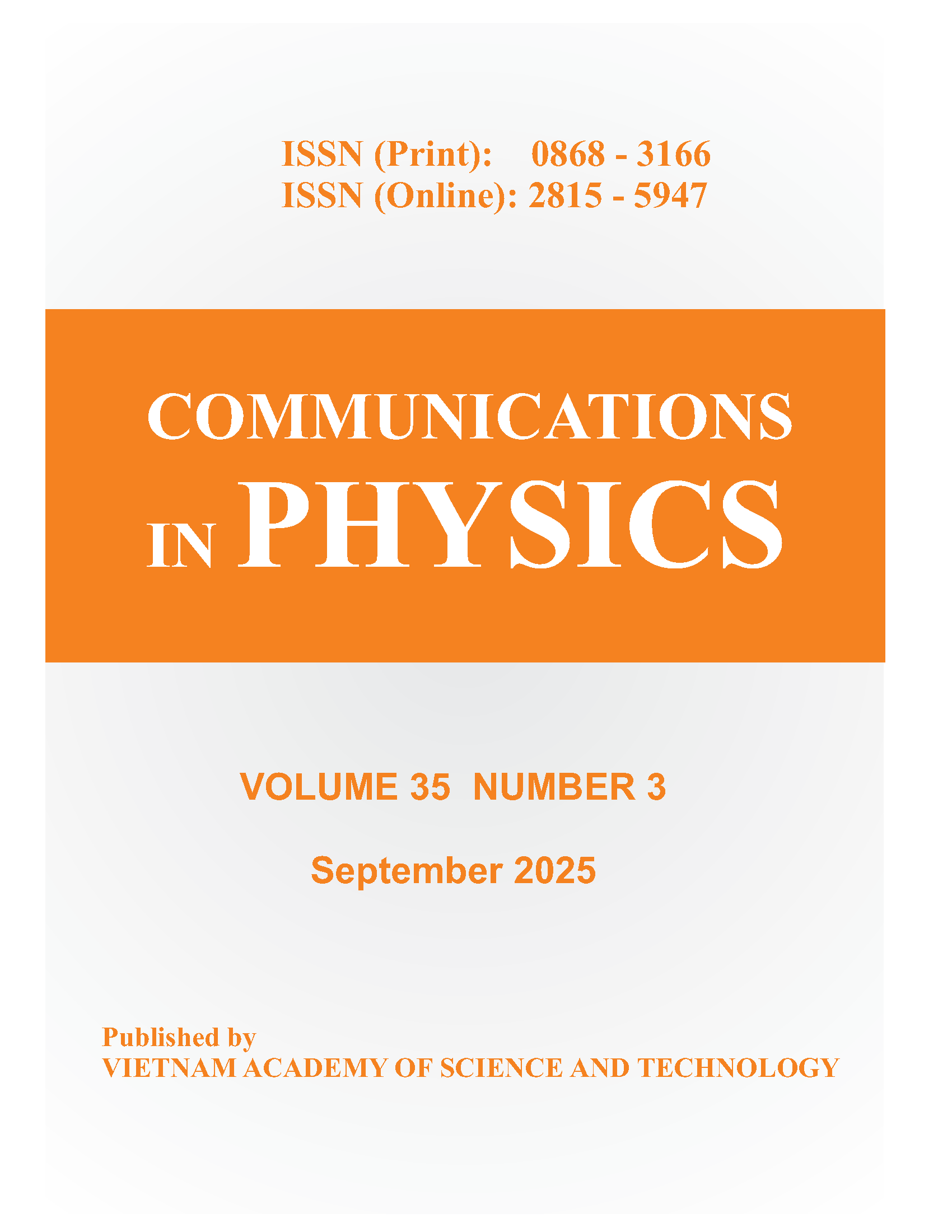Effect of precursor and calcination time on the morphological structure and catalytic activity of Co\(_{3}\)O\(_{4}\) film in the oxygen evolution reaction
Author affiliations
DOI:
https://doi.org/10.15625/0868-3166/18878Keywords:
Co3O4, film, OER., calcination timeAbstract
This research investigates the effect of cobalt precursor and calcination time on the morphology and catalytic activity of Co\(_{3}\)O\(_{4}\) films in the oxygen evolution reaction. Co\(_{3}\)O\(_{4}\) films with porous flower-like nanostructures were obtained using cobalt nitrate as a cobalt precursor, while cobalt chlorides were used to produce porous nanoneedle structures Co\(_{3}\)O\(_{4}\) film. Extended annealing time at temperature 350\r{}C caused structural fractures in the films. Among the samples, the synthesized Co\(_{3}\)O\(_{4}\) films were then evaluated as catalyst materials for the oxygen evolution reaction in alkaline 1M KOH electrolyte. Among synthesized films, the Co\(_{3}\)O\(_{4}\)-2-1h, synthesized using the cobalt chlorides as Co precursor and annealed at 350\r{}C for 1 hour, exhibited better oxygen evolution reaction catalytic activity. With its porous nanoneedle structure, the Co\(_{3}\)O\(_{4}\)-2-1h demonstrated superior performance comparable to the state-of-the-art 20\% Ir/C catalyst. Moreover, the Co\(_{3}\)O\(_{4}\)-2-1h film \copyediting{demonstrates}{demonstrated} remarkable stability for the oxygen evolution reaction in a 1M KOH alkaline electrolyte.
Downloads
References
McKinsey, Global Energy Perspective 2022 McKinsey ’ s Global Energy Perspective is a collaboration between Energy Insights and adjacent practices, Exec. Summ. (2022).
K. Kwiatkowski, V. Singer, S. Smit, Economic conditions outlook, June 2022, (2022).
K. Alanne, S. Cao, An overview of the concept and technology of ubiquitous energy, Appl. Energy. 238 (2019) 284–302.
S.S. Penner, Steps toward the hydrogen economy, Energy. 31 (2006) 33–43.
D. Chen, C.-L. Dong, Y. Zou, D. Su, Y.-C. Huang, L. Tao, S. Dou, S. Shen, S. Wang, In situ evolution of highly dispersed amorphous CoOx clusters for oxygen evolution reaction, Nanoscale. 9 (2017) 11969–11975.
S. Wang, A. Lu, C.-J. Zhong, Hydrogen production from water electrolysis: role of catalysts, Nano Converg. 8 (2021) 4.
P. Lettenmeier, J. Majchel, L. Wang, V.A. Saveleva, S. Zafeiratos, E.R. Savinova, J.-J. Gallet, F. Bournel, A.S. Gago, K.A. Friedrich, Highly active nano-sized iridium catalysts: synthesis and operando spectroscopy in a proton exchange membrane electrolyzer, Chem. Sci. 9 (2018) 3570–3579.
M. Tahir, L. Pan, F. Idrees, X. Zhang, L. Wang, J.-J. Zou, Z.L. Wang, Electrocatalytic oxygen evolution reaction for energy conversion and storage: A comprehensive review, Nano Energy. 37 (2017) 136–157.
Z. Chen, X. Duan, W. Wei, S. Wang, B.-J. Ni, Electrocatalysts for acidic oxygen evolution reaction: Achievements and perspectives, Nano Energy. 78 (2020) 105392.
Q. Pan, L. Wang, Recent perspectives on the structure and oxygen evolution activity for non-noble metal-based catalysts, J. Power Sources. 485 (2021) 229335.
X. Qin, D. Kim, Y. Piao, Metal-organic frameworks-derived novel nanostructured electrocatalysts for oxygen evolution reaction, Carbon Energy. 3 (2021) 66–100.
X. Li, X. Hao, A. Abudula, G. Guan, Nanostructured catalysts for electrochemical water splitting: Current state and prospects, J. Mater. Chem. A. 4 (2016) 11973–12000.
N.H. Chou, P.N. Ross, A.T. Bell, T.D. Tilley, Comparison of Cobalt-based Nanoparticles as Electrocatalysts for Water Oxidation, ChemSusChem. 4 (2011) 1566–1569.
M. Zhang, M. de Respinis, H. Frei, Time-resolved observations of water oxidation intermediates on a cobalt oxide nanoparticle catalyst, Nat. Chem. 6 (2014) 362–367.
C. Yuan, H. Bin Wu, Y. Xie, X.W. (David) Lou, Mixed Transition-Metal Oxides: Design, Synthesis, and Energy-Related Applications, Angew. Chemie Int. Ed. 53 (2014) 1488–1504.
S.A. Patil, D. V. Shinde, I. Lim, K. Cho, S.S. Bhande, R.S. Mane, N.K. Shrestha, J.K. Lee, T.H. Yoon, S.H. Han, An ion exchange mediated shape-preserving strategy for constructing 1-D arrays of porous CoS1.0365 nanorods for electrocatalytic reduction of triiodide, J. Mater. Chem. A. 3 (2015) 7900–7909.
S.Y. Shajaripour Jaberi, A. Ghaffarinejad, Z. Khajehsaeidi, The effect of annealing temperature, reaction time, and cobalt precursor on the structural properties and catalytic performance of CoS2 for hydrogen evolution reaction, Int. J. Hydrogen Energy. 46 (2021) 3922–3932.
H.T. Bui, N.K. Shrestha, S. Khadtare, C.D. Bathula, L. Giebeler, Y.-Y.Y. Noh, S.H. Han, Anodically Grown Binder-Free Nickel Hexacyanoferrate Film: Toward Efficient Water Reduction and Hexacyanoferrate Film Based Full Device for Overall Water Splitting, ACS Appl. Mater. Interfaces. 9 (2017) 18015–18021.
R.G. Pearson, Hard and Soft Acids and Bases, J. Am. Chem. Soc. 85 (1963) 3533–3539.
F. Wu, X. Guo, G. Hao, Y. Hu, W. Jiang, Self-supported hollow Co(OH)2/NiCo sulfide hybrid nanotube arrays as efficient electrocatalysts for overall water splitting, J. Solid State Electrochem. 23 (2019) 2627–2637.
B. Sidhureddy, J.S. Dondapati, A. Chen, Shape-controlled synthesis of Co3O4 for enhanced electrocatalysis of the oxygen evolution reaction, Chem. Commun. 55 (2019) 3626–3629.
K. Zhang, G. Zhang, J. Qu, H. Liu, Disordering the Atomic Structure of Co(II) Oxide via B-Doping: An Efficient Oxygen Vacancy Introduction Approach for High Oxygen Evolution Reaction Electrocatalysts., Small. 14 (2018) e1802760.
F. Dionigi, Z. Zeng, I. Sinev, T. Merzdorf, S. Deshpande, M.B. Lopez, S. Kunze, I. Zegkinoglou, H. Sarodnik, D. Fan, A. Bergmann, J. Drnec, J.F. de Araujo, M. Gliech, D. Teschner, J. Zhu, W.-X. Li, J. Greeley, B.R. Cuenya, P. Strasser, In-situ structure and catalytic mechanism of NiFe and CoFe layered double hydroxides during oxygen evolution, Nat. Commun. 11 (2020) 2522.
Downloads
Published
How to Cite
Issue
Section
License
Communications in Physics is licensed under a Creative Commons Attribution-ShareAlike 4.0 International License.
Copyright on any research article published in Communications in Physics is retained by the respective author(s), without restrictions. Authors grant VAST Journals System (VJS) a license to publish the article and identify itself as the original publisher. Upon author(s) by giving permission to Communications in Physics either via Communications in Physics portal or other channel to publish their research work in Communications in Physics agrees to all the terms and conditions of https://creativecommons.org/licenses/by-sa/4.0/ License and terms & condition set by VJS.











